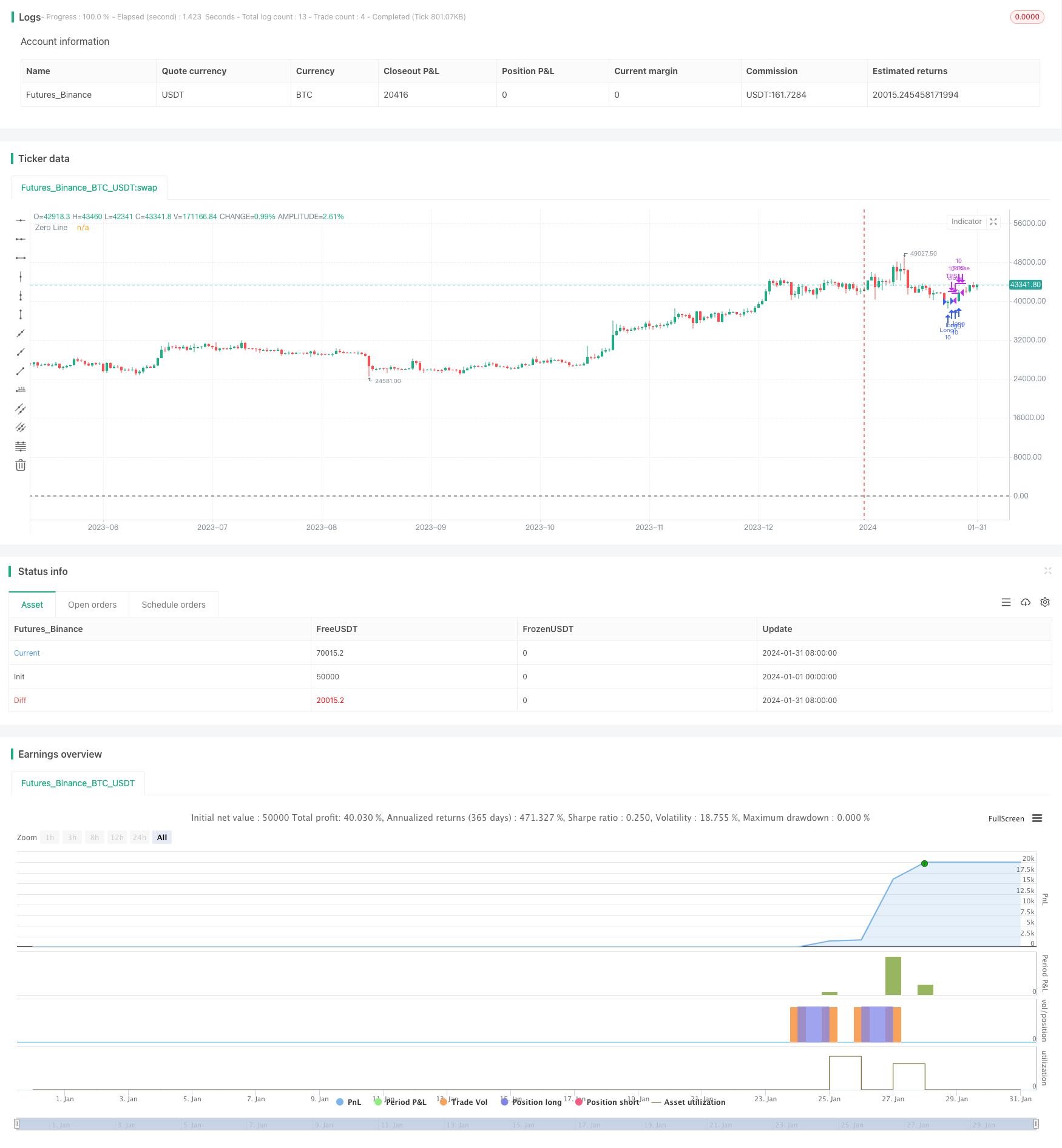
概述
3 10震荡器轮廓标记策略通过计算3日和10日简单移动平均线之间的差值作为MACD指标,结合成交量的分析来判断市场买卖盘的强弱,从而产生交易信号。该策略同时结合关键价格区域、成交量特征以及MACD指标的反转来确认进场和出场机会。
策略原理
该策略的核心指标是MACD,它由一个快速移动平均线和一个慢速移动平均线组成。快速线是3日简单移动平均线,慢速线是10日简单移动平均线。它们之间的差值构成MACD柱状线。当快速线从下方向上突破慢速线时,代表买盘力量加强,产生买入信号;反之快速线从上方向下跌破慢速线时,卖盘力量加强,产生卖出信号。
另外,该策略结合每根K线的买入成交量和卖出成交量的大小关系,判断市场买卖盘的相对强弱。具体方法是:买入成交量 = 成交量 x (收盘价-最低价)÷(最高价-最低价);卖出成交量 = 成交量 x (最高价-收盘价)÷(最高价-最低价)。如果买入成交量显著大于卖出成交量,说明该根K线以较强的买盘结束,这是一个买入信号。
通过组合MACD指标和成交量分析,该策略可以有效判断市场的供需关系和蓄势 pending 方向。同时,策略还会验证价位是否处于关键区域、MACD是否有效反转以及买卖盘成交量差异是否够大等条件,从而过滤掉一些冲动操作的噪音,确保高概率和高效率的入场。
优势分析
- 利用MACD指标判断市场蓄势方向
- 成交量差异分析判断买卖盘强弱
- 多重条件筛选,确保高概率操作
- 采用止盈止损策略,控制风险
该策略最大的优势在于充分结合市场供需关系的判断。MACD柱状线可有效判断买卖盘力量对比和市场蓄势方向;成交量差异分析可清楚辨别买卖盘的主导力量。同时策略设置多重条件进行审核,避免追涨杀跌,确保获利概率较高。此外,策略内置止盈止损机制也可限制单笔损失。
风险分析
- MACD失效风险。当市场震荡或持平盘整理时,MACD可能会产生虚假信号。
- 成交量失效风险。市场可能存在拉抬成交量的现象,这时成交量分析的准确性会降低。
- 参数优化难度大。该策略包含多个参数,优化难度较大,不适合参数调整能力较弱的投资者。
上述风险可通过以下方法加以规避:准确判断市场主要趋势,避免在震荡盘中使用该策略;关注市场信息面,识别成交量被人为拉抬的情况;调整参数要慎重,可借鉴专业机构的建议。
优化方向
该策略可从以下几个方面进行优化:
- 利用KD、布林带等指标替代或配合MACD,提高判断准确性
- 增加仓位管理机制,让策略参数动态调整
- 优化止盈止损点,实现更高的单笔盈利
- 在多时间周期运行,提高稳定性
综上,可见本策略优化空间较大,投资者可根据自身情况和市场环境进行适当调整与改进,使策略效果更佳。
总结
3 10震荡器轮廓标记策略成功融合了MACD分析、成交量比较以及多重条件过滤验证的思路。它判断供需关系和市场蓄势方向的能力较强,同时内置止盈止损机制控制风险。该策略优化空间大、应用前景广阔,值得投资者重点考虑和深入研究。
/*backtest
start: 2024-01-01 00:00:00
end: 2024-01-31 23:59:59
period: 1d
basePeriod: 1h
exchanges: [{"eid":"Futures_Binance","currency":"BTC_USDT"}]
*/
//@version=5
strategy("3 10 Oscillator Profile Flagging", shorttitle="3 10 Oscillator Profile Flagging", overlay=true)
signalBiasValue = input(title="Signal Bias", defval=0.26)
macdBiasValue = input(title="MACD Bias", defval=0.8)
shortLookBack = input( title="Short LookBack", defval=3)
longLookBack = input( title="Long LookBack", defval=10)
takeProfit = input( title="Take Profit", defval=0.75)
stopLoss = input( title="Stop Loss", defval=0.5)
fast_ma = ta.sma(close, 3)
slow_ma = ta.sma(close, 10)
macd = fast_ma - slow_ma
signal = ta.sma(macd, 16)
hline(0, "Zero Line", color = color.black)
buyVolume = volume*((close-low)/(high-low))
sellVolume = volume*((high-close)/(high-low))
buyVolSlope = buyVolume - buyVolume[1]
sellVolSlope = sellVolume - sellVolume[1]
signalSlope = ( signal - signal[1] )
macdSlope = ( macd - macd[1] )
//plot(macdSlope, color=color.red, title="Total Volume")
//plot(signalSlope, color=color.green, title="Total Volume")
intrabarRange = high - low
getLookBackSlope(lookBack) => signal - signal[lookBack]
getBuyerVolBias(lookBack) =>
j = 0
for i = 1 to lookBack
if buyVolume[i] > sellVolume[i]
j += 1
j
getSellerVolBias(lookBack) =>
j = 0
for i = 1 to lookBack
if sellVolume[i] > buyVolume[i]
j += 1
j
getVolBias(lookBack) =>
float b = 0
float s = 0
for i = 1 to lookBack
b += buyVolume[i]
s += sellVolume[i]
b > s
getSignalBuyerBias(lookBack) =>
j = 0
for i = 1 to lookBack
if signal[i] > signalBiasValue
j += 1
j
getSignalSellerBias(lookBack) =>
j = 0
for i = 1 to lookBack
if signal[i] < ( 0 - signalBiasValue )
j += 1
j
getSignalNoBias(lookBack) =>
j = 0
for i = 1 to lookBack
if signal[i] < signalBiasValue and signal[i] > ( 0 - signalBiasValue )
j += 1
j
getPriceRising(lookBack) =>
j = 0
for i = 1 to lookBack
if close[i] > close[i + 1]
j += 1
j
getPriceFalling(lookBack) =>
j = 0
for i = 1 to lookBack
if close[i] < close[i + 1]
j += 1
j
getRangeNarrowing(lookBack) =>
j = 0
for i = 1 to lookBack
if intrabarRange[i] < intrabarRange[i + 1]
j+= 1
j
getRangeBroadening(lookBack) =>
j = 0
for i = 1 to lookBack
if intrabarRange[i] > intrabarRange[i + 1]
j+= 1
j
bool isNegativeSignalReversal = signalSlope < 0 and signalSlope[1] > 0
bool isNegativeMacdReversal = macdSlope < 0 and macdSlope[1] > 0
bool isPositiveSignalReversal = signalSlope > 0 and signalSlope[1] < 0
bool isPositiveMacdReversal = macdSlope > 0 and macdSlope[1] < 0
bool hasBearInversion = signalSlope > 0 and macdSlope < 0
bool hasBullInversion = signalSlope < 0 and macdSlope > 0
bool hasSignalBias = math.abs(signal) >= signalBiasValue
bool hasNoSignalBias = signal < signalBiasValue and signal > ( 0 - signalBiasValue )
bool hasSignalBuyerBias = hasSignalBias and signal > 0
bool hasSignalSellerBias = hasSignalBias and signal < 0
bool hasPositiveMACDBias = macd > macdBiasValue
bool hasNegativeMACDBias = macd < ( 0 - macdBiasValue )
bool hasBullAntiPattern = ta.crossunder(macd, signal)
bool hasBearAntiPattern = ta.crossover(macd, signal)
bool hasSignificantBuyerVolBias = buyVolume > ( sellVolume * 1.5 )
bool hasSignificantSellerVolBias = sellVolume > ( buyVolume * 1.5 )
// 7.48 Profit 52.5%
if ( hasSignificantBuyerVolBias and getPriceRising(shortLookBack) == shortLookBack and getBuyerVolBias(shortLookBack) == shortLookBack and hasPositiveMACDBias and hasBullInversion)
strategy.entry("Short1", strategy.short, qty=10)
strategy.exit("TPS", "Short1", limit=strategy.position_avg_price - takeProfit, stop=strategy.position_avg_price + stopLoss)
// 32.53 Profit 47.91%
if ( getPriceFalling(shortLookBack) and (getVolBias(shortLookBack) == false) and signalSlope < 0 and hasSignalSellerBias)
strategy.entry("Long1", strategy.long, qty=10)
strategy.exit("TPS", "Long1", limit=strategy.position_avg_price + takeProfit, stop=strategy.position_avg_price - stopLoss)